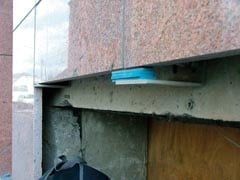Setting the standard : BS 8298
It can be hard to keep up with all the standards for building products, especially as they frequently change. In this column, Barry Hunt throws some light on the standards, identifying those you need and those you don’t. This time he looks at the requirements for cladding and lining.
For many years BS 8298: Code of Practice for the Design and Installation of Natural Stone Cladding & Lining, seemed to stand alone as the one useful standard for natural stone.
It was originally developed from the code of practice published by Stone Federation Great Britain. It was first published in 1989 and updated in 1994.
With many recent advancements in cladding practice and changing requirements, another update was long overdue by the time it arrived at the very end of last year.
BS 8298 has now been split into five parts to reflect the major types of cladding, with the first part being a general introduction. The fifth part, relating to internal linings, is still in preparation, which might be seen as another reason for splitting up the original standard.
The separation shows. It has resulted in potential conflicts between the different parts, although these are mostly minor. More cynically, the splitting of the original standard seems a good way of extracting more money from users.
The separate parts of BS 8298 have their own merits and some are more worthwhile than others, although if you deal with cladding you will probably feel duty bound to purchase them all.
I will deal with the merits of the different parts of this standard in future issues of this column.
The set of BS 8298 standards together presently costs £578. That will increase to more than £700 once the part for linings appears.
The recently superseded 1994 version (which is still cited in the Building Regulations, so you still need it) costs £156.
This standard is a bit like buying insurance: you know you are being over-charged but the potential consequences of not purchasing it are just too scary.
BS 8298 now includes significantly more helpful tables and figures, which is always a good sign. Many of the tables and figures from the 1994 version also remain, keeping a degree of consistency.
In total there are close to 40,000 words of text spread over 134 pages, although around 40 of these pages are titles, blank pages or of no great consequence. In reality, a single 100-page document could have been produced for a price of, say, £150, which would not have been unreasonable.
As a set, these standards, I have to admit, cannot be deemed to be anything other than extremely useful. I would award BS 8298 nine out of 10 on this basis.
Applying the Barry Hunt arbitrary value for money (VFM) rating that I introduced in this column last month, I am going to award the full set of standards 46%. So not a bad effort but room for improvement, mainly in the price.
In light of the expansion of BS 8298, the Stone Federation has just published a guide to the presently available parts. This is free to members and their clients but is not generally available. While the document is not intended to replace BS 8298 it should help the Federation’s members decide which parts they really need. This is just one of the many benefits Stone Federation members receive.
References:
BS 8298: Code of practice for the design and installation of natural stone cladding and lining.
Part 1:2010 – General
Part 2:2010 – Traditional handset external cladding
Part 3:2010 – Stone-faced pre-cast concrete cladding systems
Part 4:2010 – Rainscreen and stone on metal frame cladding systems
Part 5 – Internal linings (yet to be published)
All published by the British Standards Institution, London, England.

